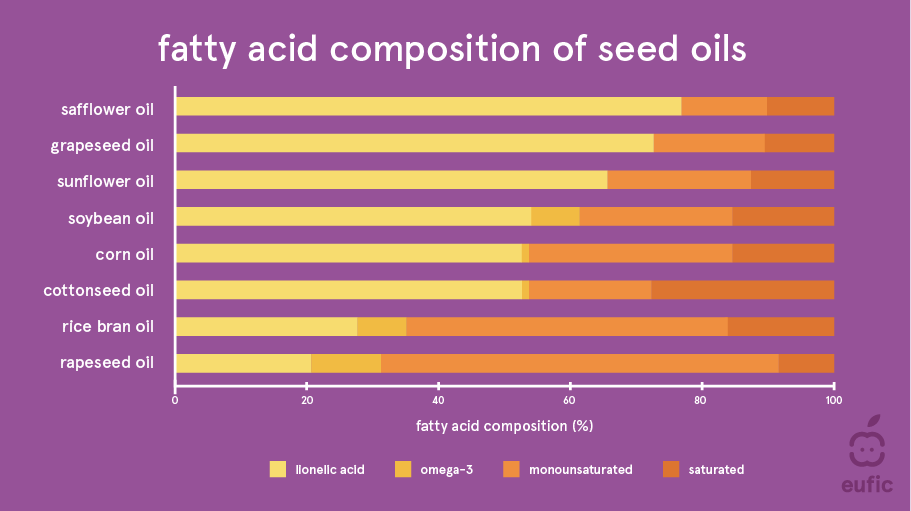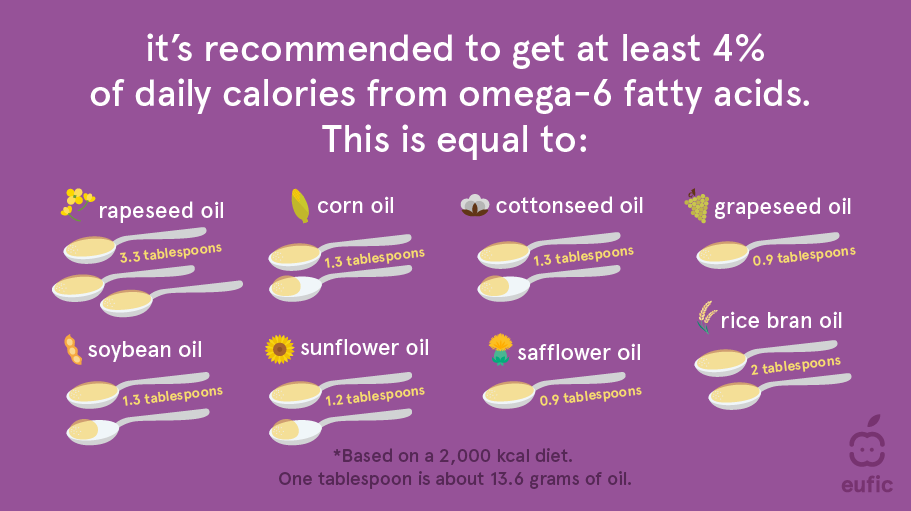Do seed oils cause inflammation?
Last Updated : 19 March 2025
Seed oils are oils extracted from the seeds of various plants. You’ll recognise them as rapeseed (or canola), corn (maize), cottonseed, grapeseed, soybean, sunflower, safflower, and rice bran oil. They’re affordable, have a high smoke point (meaning they are stable at high temperatures, which makes them suitable for frying), and many are rich in vitamins E and K. So, why are many on social media advocating to ditch seed oils because they supposedly cause inflammation? Let’s debunk this myth.
What are the types of fats found in seed oils?
The fats in food are made up of different types of building blocks called fatty acids. These fatty acids are grouped into four main types: saturated fats, monounsaturated fats, polyunsaturated fats, and trans-fat. Every type of fat or oil you eat, like butter, olive oil, or sunflower oil, is a mix of these different kinds.
Most seed oils are particularly high in a specific type of polyunsaturated fatty acid (PUFA) called linoleic acid.1 It’s often claimed that this fatty acid causes inflammation and disrupts the balance with omega-3 fatty acids, another type PUFA, leading to various health problems. However, this oversimplified view is not supported by evidence. Let’s break it down.

Fig. 1 – Fatty acid composition of seed oils.1-3
What is the role of linoleic acid?
Linoleic acid is an essential omega-6 fatty acid that we need to get from our diet because our body can’t make it. Linoleic acid is, for example, necessary to produce cell membranes and plays a role in maintaining healthy skin. Our body can convert linoleic acid into arachidonic acid, another type of PUFA, which is involved in the production of inflammatory compounds in the body. Does this mean eating seed oils cause inflammation? Not exactly. Only a tiny fraction of the linoleic acid we eat is converted into arachidonic acid. If we eat more (or less) seed oils, we don’t see much change in arachidonic acid levels.4 Arachidonic acid levels are kept at a relatively constant level in the body.
Does the omega-6 to omega-3 ratio matter?
Omega-6 and omega-3 fatty acids have different roles in the body, so it’s important to get the right amount of both to avoid chronic diseases and maintain good health.
Omega-6 and omega-3 fatty acids compete for the same enzymes (molecules which act as catalysts, speeding up chemical reactions in our body) to turn into their more active forms. The active form of omega-6, called arachidonic acid, produces compounds with slightly more pro-inflammatory (inflammation-causing effects) and pro-coagulatory effects (blood clotting effects), while omega-3’s active forms (eicosapentaenoic acid (EPA) and docosahexaenoic acid (DHA)) produce anti-inflammatory, anti-coagulatory compounds. Because of this, some people believe that eating too much omega-6 can lead to more inflammation by throwing off the balance between these fats.
However, current research from randomised controlled trials show that this isn’t the case. These studies show that adding linoleic acid (a common omega-6 fatty acid, abundant in seed oils) to the diet doesn’t increase the concentration of inflammatory markers.5-6 In fact, people with higher levels of linoleic acid may actually have a lower inflammatory status.7
There’s been a lot of discussion about the ideal balance between omega-6 and omega-3 fats in our diet. Today, most people eat about 10 to 20 times more omega-6 than omega-3 fatty acids, mainly because our diets are rich in processed foods and cooking oils (like seed oils) high in omega-6 fatty acids, while omega-3 sources – such as fatty fish (e.g., salmon, mackerel, sardines), flaxseeds, and walnuts – are eaten less often. Omega-3 fats, especially EPA and DHA, are linked to various health benefits, such as lowering the risks for cardiovascular diseases.8 Some studies suggest that eating too much omega-6 fats, without enough omega-3 fats, may contribute to an increased risk of early death, cancer, and cardiovascular mortality.9
Experts now believe that instead of focusing on the ratio of omega-6 to omega-3 fatty acids, it’s more important to make sure we’re getting enough omega-3 fats. Increasing our intake of EPA and DHA, the primary omega-3 fatty acids, is recommended as a more effective strategy to improve our omega-3 status and potentially mitigate health risks compared to lowering our intake of linoleic acid (a common omega-6 fatty acids, abundant in seed oils).10
Why don’t seed oils cause more inflammation?
Why don’t we see more inflammation with more linoleic acid (the most common type of fatty acid in seed oils)? This is because the body has mechanisms in place to keep things in balance. Arachidonic acid (a type of omega-6 fatty acid the body makes from linoleic acid and is involved in the production of inflammatory compounds) plays a more complicated role – it can both start and help resolve inflammation, depending on the overall makeup of your diet.
It's important to remember that we don’t eat fatty acids in isolation. The health effects of seed oils depend on the mix of fats and other nutrients they contain, like vitamin E, which can also affect inflammation due to its antioxidant effects. Moreover, inflammation is a complex process – it’s not always harmful (e.g., when you get injured or sick, inflammation is the body’s way of protecting itself by fighting of infections, repairing damaged tissue, and triggering the healing process) and is influenced by many things like your genes, lifestyle, and overall diet. What matters most is the balance of the diet as a whole, not just how much seed oil you eat.
How much omega-6 fats should we eat?
Omega-6 and omega-3 fatty acids both play important roles in our body. A healthy diet should include a mix of both fats, rather than aiming for a strict ratio. Reducing omega-6 consumption, especially by cutting out seed oils, could harm cardiovascular health, as omega-6 fatty acids are known to help lower cholesterol and blood sugar levels.
The American Heart Association recommends getting 5-10% of daily calories from omega-6 fatty acids to reduce the risk of heart disease.11This is equal to about 100-200 kcal from omega-6 fatty acids (about 11-22 g of omega-6 fatty acids). For example, this would be 20-39 g of sunflower oil.
The European Food Safety Authority (EFSA) suggests that at least 4% of our daily calorie intake should come from omega-6 fats. Current research shows no clear evidence that eating omega-6 fats harms health or contributes to diet-related diseases. Therefore, EFSA does not recommend setting an upper limit on how much omega-6 you can safely eat.12
At the same time, it’s recommended to eat at least 250-500 mg of omega-3 fatty acids (EPA and DHA) daily for good health.13,14 This can be achieved by eating, for example, about two servings (140 g per serving) of fatty fish per week, such as salmon, mackerel, or sardines. Other sources include flaxseeds and walnuts, but their omega-3 content is in a different form (alpha linolenic acid (ALA)), which the body converts less efficiently to EPA and DHA.

Fig. 2 – How much omega-6 fatty acids are in seed oils?
Takeaways
- Eating seed oils doesn’t increase inflammation. In fact, studies show that higher levels of linoleic acid (the main fat in seed oils) may be linked to lower inflammation in the body.
- Your overall diet matters more than avoiding specific foods. Seed oils are a healthy source of fats and contain nutrients like vitamin E, which has antioxidant properties that support your health.
- Seed oils can be part of a heart-healthy diet. Omega-6 fats, like those in seed oils, are known to help lower cholesterol and blood sugar levels. Health authorities, such as EFSA, recommend getting at least 4% of your daily calories from omega-6 fats for good health.
- Most dietary guidelines and international and European health bodies, including the World Health Organization and the European Society of Cardiology, recommend we aim to get less than 10% of our total daily energy from saturated fats (e.g., found in butter, palm oil, and coconut oil) to reduce our chronic disease risk and reductions should be achieved by replacing them with unsaturated fats, particularly polyunsaturated fats found in soybean, rapeseed (canola), corn, safflower, and sunflower oil.15,16
This article is part of a series on seed oil myths:
Do seed oils cause chronic diseases?
Does the processing of seed oils pose a health risk?
Do seed oils promote oxidative stress?
References
- Composition of foods integrated dataset (CoFID).
- Dutch Food Composition Database (NEVO). (2021). NEVO-online version 2021/7.1. Accessed 22 January 2025.
- U.S. Department of Agriculture, Agricultural Research Service, Beltsville Human Nutrition Research Center. FoodData Central. https://fdc.nal.usda.gov/.
- Rett BS, Whelan J. (2011). Increasing dietary linoleic acid does not increase tissue arachidonic acid content in adults consuming Western-type diets: a systematic review. Nutrition & Metabolism 8(1):36. doi: 10.1186/1743-7075-8-36.
- Johnson GH, Fritsche K. (2012). Effect of dietary linoleic acid on markers of inflammation in healthy persons: a systematic review of randomized controlled trials. Journal of the Academy of Nutrition and Dietetics 112(7):1029-1041.
- Su H, Liu R, Chang M, Huang J, Wang X. (2017). Dietary linoleic acid intake and blood inflammatory markers: a systematic review and meta-analysis of randomized controlled trials. Food & Function 8(9):3091-3103.
- Fritsche KL. (2008). Too much linoleic acid promotes inflammation—doesn’t it? Prostaglandins, Leukotrienes and Essential Fatty Acids 79(3-5):173-175.
- Jang, H., & Park, K. (2020). Omega-3 and omega-6 polyunsaturated fatty acids and metabolic syndrome: A systematic review and meta-analysis. Clinical Nutrition, 39(3), 765-773.
- Zhang, Y., Sun, Y., Yu, Q., Song, S., Brenna, J. T., Shen, Y., & Ye, K. (2024). Higher ratio of plasma omega-6/omega-3 fatty acids is associated with greater risk of all-cause, cancer, and cardiovascular mortality: a population-based cohort study in UK
- Harris WS, Mozaffarian D, Rimm E, Kris-Etherton P, Rudel LL, Appel LJ, et al. (2009). Omega-6 fatty acids and risk for cardiovascular disease: a science advisory from the American Heart Association Nutrition Subcommittee of the Council on Nutrition, Phy
- Harris, W. S. (2018). The Omega-6: Omega-3 ratio: A critical appraisal and possible successor. Prostaglandins, Leukotrienes and Essential Fatty Acids, 132, 34-40.
- European Food Safety Authority (EFSA). (2017). Dietary reference values for nutrients summary report. EFSA Journal 14(12):e15121E.
- Vannice, G., & Rasmussen, H. (2014). Position of the academy of nutrition and dietetics: dietary fatty acids for healthy adults. Journal of the Academy of Nutrition and Dietetics, 114(1), 136-153
- EFSA Panel on Dietetic Products, Nutrition and Allergies (NDA). (2012). Scientific Opinion on the Tolerable Upper Intake Level of eicosapentaenoic acid (EPA), docosahexaenoic acid (DHA) and docosapentaenoic acid (DPA). EFSA Journal, 10(7), 2815.
- World Health Organisation (WHO)., 2018. Draft Guidelines: Saturated fatty acid and trans-fatty acid intake for adults and children.
- Piepoli, Massimo F., et al. "2016 European Guidelines on cardiovascular disease prevention in clinical practice: The Sixth Joint Task Force of the European Society of Cardiology and Other Societies on Cardiovascular Disease Prevention in Clinical Pract